Russo-Ukrainian War: Schrodinger’s Offensive
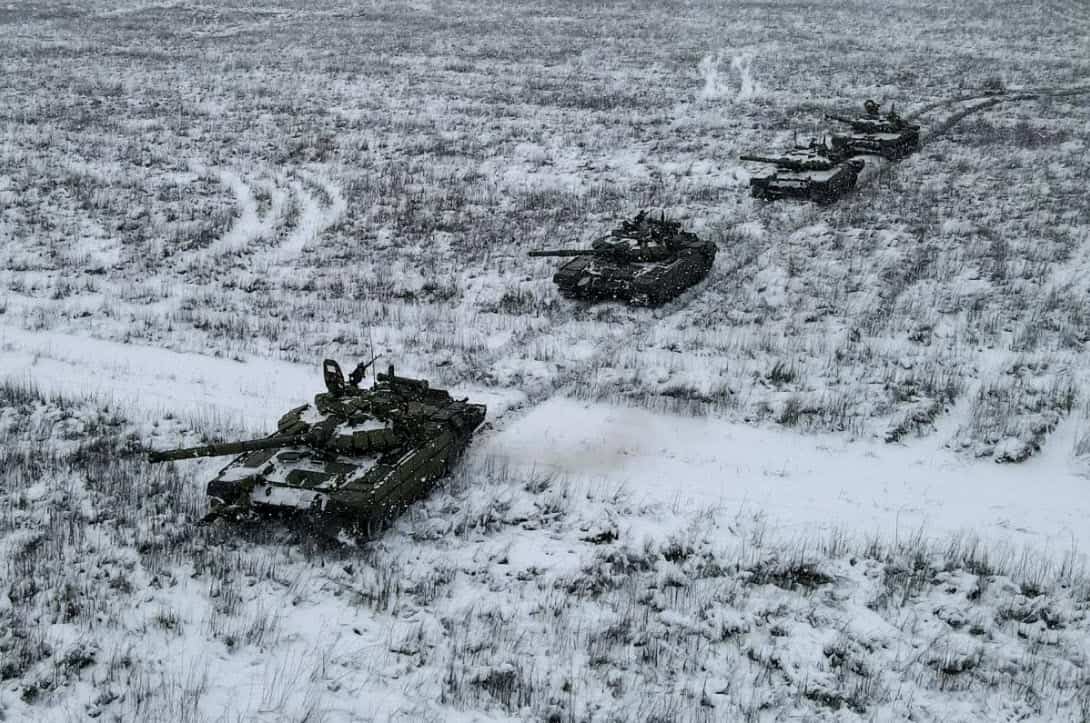
Winter War on the Steppe
by Big Serge, Substack [3-1-2023 published].
A ramble about force design, Moldova, and a fortress on the steppe.
(This long article illustrates how "armchair commentators" who don't fully understand military strategies & conditions on the ground & the relative strengths of the opposing forces will not be able to see the bigger picture. Big Serge is a student of military strategies that go back thousands of years. Consider reading this article, not for the details, but to get an overall feeling for the complexity of the war between NATO & Russia that is being fought in Ukraine. You might even want to read "Summary: Life in the Death Pit" at the end first. I've also added "Big Serge Thought" at the end which points you to the many informative Substack articles he has written. — RAD)
Where is the big Russian offensive? This is, at the moment, the million dollar question that inevitably intrudes on any discussion of
war’s current course. It is probably not surprising (to those of us that are familiar with human nature, at least) that this question becomes a Rorschach test in which everybody sees their own prior assumptions about the Russian military.
The answers to this question do indeed vary widely. On one extreme, there are those who believe that hundreds of thousands of Russian troops are prepared to launch an enormous “big arrow” offensive at any moment. We see this both from commentators like retired US Colonel Douglas MacGregor and from some Ukrainian sources who are likely trying to foment a sense of urgency to extract more aid from the west. On the other extreme, we have those who claim that the Russian military is so depleted that there will be no offensive at any point whatsoever. There are also some in the Reich Ministry of Public Enlightenment and Propaganda western intelligentsia, like the Nuland Institute for the Study of War or Michael Koffman, who argue that the offensive has already begun but is so lame and weak that nobody noticed.
Okay. So either a giant offensive will happen any minute now (it might have just started while I was typing that), or it will never happen at all, or it already happened, or perhaps it’s in a state of quantum superposition in which it has both succeeded and failed, at least until we open the box.
A thorny issue indeed. There is, at the moment, a great deal of important and intense combat occurring in many different sectors of front - but what relation do these operations have to any big arrow action by the Russians? Is this an underwhelming entrée or an appetizer?
I would like to suggest an alternative to all these theories, because what the world needs most right now is more opinions.
At the moment, Russia has the initiative across the front. Ukraine’s reserves are in a tenuous state right now (especially given their politically imposed mandate to try and accumulate a force for an offensive against the land bridge to Crimea), and Russia is driving high intensity combat in important sectors right now.
These operations, I would argue, serve three different purposes at once. First and foremost, they are valuable shaping operations in their own right that have important implications for launching future operations. Secondly, they function essentially as spoiling attacks in that they keep the burn rate at the front high and degrade Ukraine’s ability to form reserves. As a sort of metaphor for this, there are already rumors that some of Ukraine’s new Leopard tanks will be sent into combat around Bakhmut rather than held in reserve for a future offensive. Whether the Leopard rumor is true or not, in manpower terms Ukraine continues to pump units into Bakhmut in an unconscionable waste of men. Third and finally, all the combat in the east is occurring under an umbrella where Russia’s supply lines and ISR are robust, creating conditions where Ukraine continues to trade at abysmal loss ratios.
The synthesis of all these points is that Russia is currently driving the attrition of the Ukrainian army and denying Ukraine any chance at regaining operational initiative, while at the same time pursuing important shaping objectives. I believe this is occurring against the backdrop of moderate, but not catastrophic organizational disorder and restructuring in the Russian armed forces, which are delaying its readiness to launch a large scale offensive. In other words, the current pace of Russian operations supports the overall attrition of Ukrainian manpower and implies that there is no need to rush an ambitious operation until organizational issues have been sorted out.
In the remainder of this space, I’d like to examine what these organizational considerations are and examine two of the ongoing Russian operations (the Ugledar and Kreminna axes), looking at them on a fairly granular scale. We’ll also briefly touch on the bizarre rumors of an immanent widening of the war towards Moldova.
I apologize for the time which sometimes lapses between articles, but as you will see my writing often metastasizes and these entries become much longer than I initially anticipate, and may technically qualify as novellas based on word count. In any case, I hope that the volume and quality of the content may compensate for the interval, and if not the comment section is open for you to voice your displeasure and anti-Serge polemics.
Organizing an Army
For young men, fascination with war goes through distinct phases. Most of the time it begins with equipment and broad, big arrow views of battles. The sizes of the cannons on the main battle tanks of World War Two, for example, is probably a disproportionately well known fact among 8-16 year old boys. They mostly want to know about the big battles, the big movement patterns, and big guns.
Over time, however, the inescapable conclusion sets in that armies have an intensely bureaucratic backbone, and that seemingly mundane factors like unit composition, rear area logistics, and organizational charts have tremendous implications on the battlefield. This is where those dreaded order of battle charts and unit diagrams come into play, and you inevitably have to start memorizing what the myriad little symbols mean. Eventually, you realize that the construction of units and other organizational factors are, within reason, far more important than the minutia of the equipment and armaments, and you should have been contemplating the bureaucratic aspects the whole time, and that (tragically) the size of the cannon on the Sherman Firefly tank was not actually a particularly decisive factor in world history.
It still looks cool, for the record.
Russia is currently sorting through organizational issues which were created through the country’s unique mixed service model (which mixes contract soldiers and conscripts), and in particular the wearisome Battalion Tactical Group (BTG).
I talked about the Battalion Tactical Group at length in a previous article, but let’s briefly recap. The Russian army utilizes a mixed model of professional contract soldiers and conscripts, and these two types of personnel have an important legal differentiation. Conscripts cannot be deployed in combat outside of Russia without a declaration of war. This means that a given Russian unit (let’s just use a brigade as the standard example) has a full (“paper”) strength comprised of mixed personnel, and a rump core of contract soldiers that can be deployed abroad. The question for Russian leadership therefore becomes how to design these units to fight without their conscripts. The answer to this problem was the Battalion Tactical Group, which is a derivative formation that spins off (if you will) from the brigade. The design of these units has other considerations of course, but the basic concern driving the creation of the BTG was the need to craft a force that could fight without its conscripts.
The BTG, as has been noted, is heavy on firepower, with a strong organic complement of artillery tubes and armored vehicles, but exceptionally light on infantry. This has implications for both offensive and defensive operations, which we saw very clearly in the first nine months of the war in Ukraine.
On the defense, the BTG (being infantry poor) has to fight from behind a thin screen, and inflict defeats on the enemy with its ranged fires. This isn’t a unit that can fight doggedly to hold forward positions; it’s built to maul the attacker. More generally, however, BTGs are fragile units, by which we mean relatively low losses in infantry or tanks make them unsuitable for further combat tasks. This makes the unit something of a glass cannon - capable of dealing out tremendous firepower but not built to sustain operations after moderate losses. Being a fundamentally “slimmed down” unit, it struggles to sustain and recover combat capability without rotating to the rear to receive replacements or cannibalizing other units.
In a sense, this is what you’d expect given the constraints of the contract-conscript model, which by its very nature forced the Russians to design a stripped-down, manpower light subsidiary to their full strength brigades. This is why Russia had a general scarcity of manpower that began to compromise its overall operational effectiveness over the summer of 2022 as Ukrainian mobilization and western aid resulted in an enormous UA numerical advantage. At the peak, the first phase of the war probably saw no more than 80,000 regular Russian combat personnel in Ukraine, and even with the DNR, LNR, and Wagner providing an infantry buffer, the total Russian force was outnumbered at least 3-1. The BTG could still inflict huge damage, but the construction of the force in Ukraine was simply not sufficient for the scope of the theater, leading to a huge section of front in Kharkov being hollowed out. Hence, mobilization.
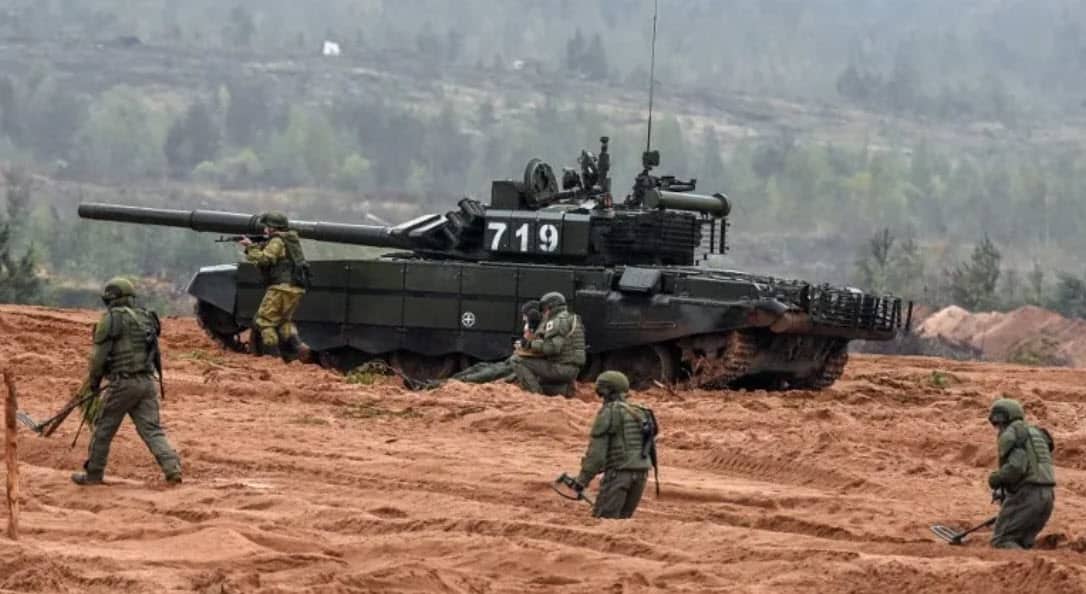
The Battalion Tactical Group proved to be a powerful but fragile unit
Here is where the signs of organizational issues begin to appear. The time had come, with mobilization finally giving Russia the deployable manpower that it needed, to pivot away from infantry poor BTGs and begin conducting large unit operations, but it is clear that the organizational process for incorporating mobilized personnel into the army and assembling large units (brigades and higher) has not been efficient. The mobilized seem to have initially been utilized in a variety of ways. Some were sent to existing units in the operations zone as replacements, others were placed into new units comprised entirely of mobilized personnel. The result is a grab bag of variegated units that have yet to be organized into large units for offensive operations.
A bit of chaos was probably to be expected, given that nobody alive has experience conducting a general mobilization for a continental war, and the entire process for Russia is a bit murky due to the many different classes of personnel and the legal barrier to utilizing conscripts. Broadly, however, it seems clear that the process of pivoting from the stripped down BTG expeditionary army back to larger parent formations has been inefficient, and Russia is still in the process of forming large units. Additionally, there remains something of a backlog delivering upgraded infantry fighting vehicles (BMPs especially) to the forming motor rifle units.
Against the backdrop of this process, Russian Defense Minister Sergei Shoygu announced a new program of military reorganization. Perhaps the most significant item on the list of changes is the decision to begin converting existing brigades into divisions. This may sound like bureaucratic vanity, but it is not. Let’s discuss.
At the end of the Cold War, the Soviet Union wielded the largest and most powerful army in the world, capable of fielding millions of men, armed to the teeth with unparalleled inventories of all manner of heavy equipment. The fact that this powerful military apparatus saw virtually no mutinies or breakdown at the end and yet it was not deployed to preserve the communist system is one of the great curiosities of modern history, but that is a story for another time.
In any case, in the wake of the Soviet collapse, Russia inherited the bulk of the Soviet military legacy, but amid economic turmoil and general societal distress, it could hardly afford to keep this massive force active (nor did it have the men, having lost access to much of the Soviet manpower pool). This led Moscow to convert much of the Soviet Army into what are known as “Cadre Formations” - essentially, a particular division would be stripped down to skeleton personnel (as small as a few hundred, mostly officers and NCOs) who would form the core around which the division would be brought back up to combat strength. Thus, those enormous Soviet divisions could be downsized to warehouses full of equipment and a small pool of cadre personnel, more or less putting the division into hibernation for future use.
In 2008, Russia undertook a major military restructuring under former Defense Minister Anatoly Serdyukov. The 2008 reforms were a belated attempt to transition away from the Soviet leftover army. Elements of the reorganization included the elimination of the cadre divisions and a move to convert all the existing divisions into brigades. This moved Russia away from the Soviet division structure towards a more western brigade model.
The dual effect of eliminating cadre formations and downsizing divisions to brigades was to slim down a bloated officer corps and create a more streamlined force. While a few divisions were retained, these were the exception rather than the rule. In general, a Russian brigade is perhaps 40-50% the size of an equivalent type division - IE, a Motor Rifle Division might be 8,500 men strong, but a Motor Rifle Brigade may be around 3,500-4,000 men.
Russia’s move to downsize from divisions to brigades was beneficial during peacetime - it reduced the cost of a bloated overstretched officer corps, and generally supported Russia’s austerity regime. Armies, however, are ultimately built for war.
Russian leadership has clearly concluded that the stripped down, manpower-lite army is not adequate for a high intensity war. This fits the overall lesson learned by everyone involved - war is still an industrial enterprise, and success requires mass - big units firing lots of shells. Thus, NATO’s admission that the expenditure of ammunition vastly outstrips their production capacity and Russia’s decision to expand the army are two sides of the same coin.
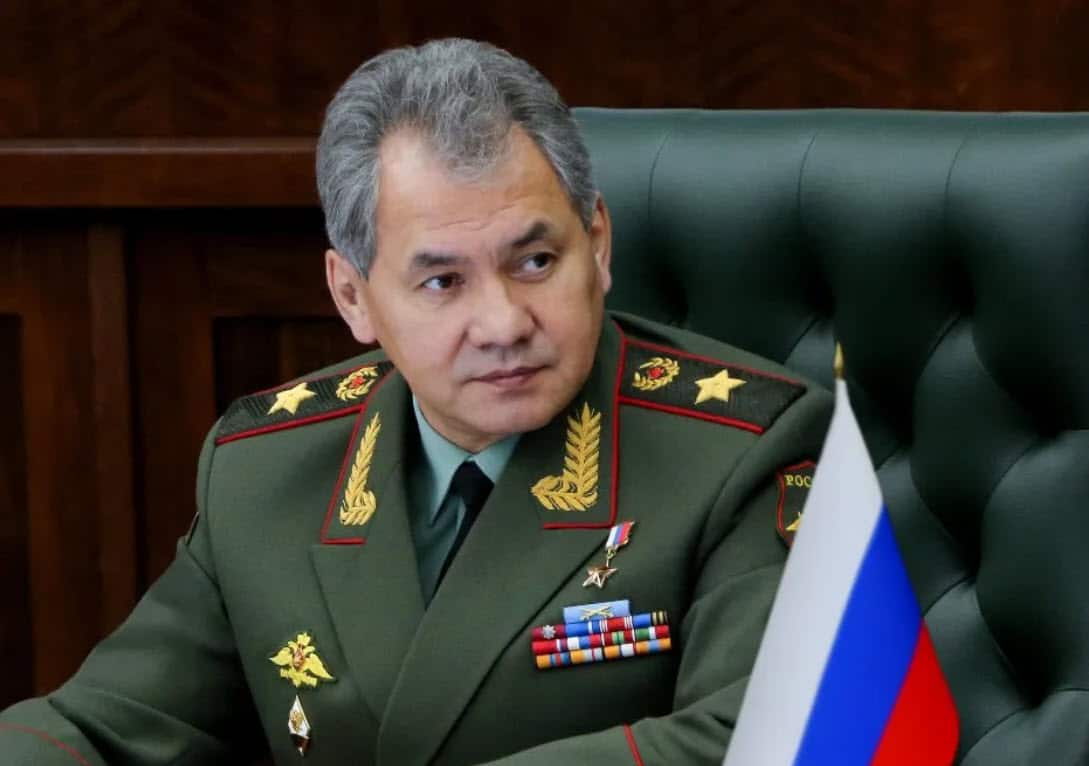
Shoigu’s announcement of a reversion to Divisional structure indicates a desire for more robust formations
This brings us back to Shoigu’s announcement that existing brigades will be converted back into divisions - effectively undoing a key element of the 2008 reforms. Russia’s experience in Ukraine has shown that stripped down units are simply not robust enough (particular in terms of manpower) to sustain themselves adequately in combat.
The picture that emerges is that of a Russian Army that is attempted to manage three different transitions at once. Namely: (1) the intake of a large number of mobilized personnel who have to be organized into large units capable of offensive operations, (2) an overall expansion and reorganization of the army back into a divisional structure, and (3) a massive expansion in armaments production, with the Russian military-industrial complex retooling to produce a mix of systems based on the experience of combat in Ukraine.
It seems like the most likely verdict is that at this point in time, these organizational challenges are not fully resolved, limiting immediate Russian activity to shaping operations and the maintenance of attritional death pits (like Bakhmut) under the safety of Russia’s ISR and fires umbrella in the east. This will continue until the regular Motor Rifle and Tank units are ready for attacking operations.
This is why, at the moment, much of Russia’s offensive duties are being handled by units at the high and low end of the unit spectrum - that is, either elite units like VDV (airborne) and Marines, or irregular units like Wagner and the DNR/LNR. The middle rung of the ladder - regular motor rifle units - are mostly visible holding defensive positions.
This is not to say that mobilization has not already had a major effect on the battlefield. The conditions that allowed Ukraine’s offensive in Kharkov oblast last autumn have been rectified. There are no longer thinned out sections of front, and Russia’s positions are now properly manned. Ukraine to this date in the war still has not successfully broken through a strongly held Russian position, and mobilization has allowed Russia to at last properly man the enormous front. It has not, however, led to a visible increase in offensive force generation, and it would seem that this is broadly due to the organizational chaos associated with rolling the BTGs back up into brigades and divisions.
From the Russian point of view, that’s the bad news. The good news is that even with much of the mobilized army still in a state of organizational flux, Russian combat strength is more than enough to sustain combat on existing axes, disrupting Ukraine’s attempts to accumulate reserves and pursuing important shaping objectives.
Lost in the Woods
As the world endlessly debates Schrodinger’s Offensive, something significant is being missed. Regardless of the absence, now or in the future, of “big arrows” that look nice on a map, the combat that is ongoing right now in the Donbas is very important from an operational perspective. Let us shrink the scope down and look at an unloved little section of front and think about what is going on there at the moment. In particular, I would like to look at the Kreminna axis.
Kreminna is a small town of no more than 20,000 people (prewar) with a rather serendipitous location. It sits near the border of the Lugansk and Donetsk oblasts, and in particular it occupies the spot where a critical rail line approaches the dominant geographic feature in the area, which is the Donets River (alternately called the Severodonetsk River).
Rivers are always important, but the Donets particularly so, because its banks - in particular the northern bank - are the site of a thick forest belt (some of it natural, but largely a plantation forest). This forest has become a critical feature of combat in this sector.
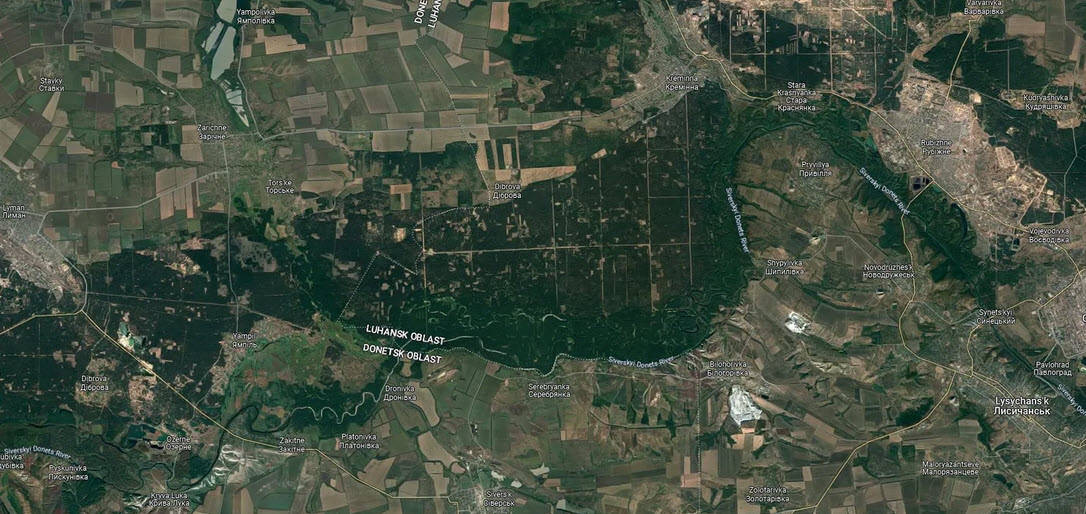
The Donets Forest Belt
Over the summer of 2022, forested zones such as this one became one of the first signs that Russia needed to raise its force deployment in Ukraine. Both in this belt along the Donets and in a similar forest zone around Izyum, Russian forces had difficulty fully sealing the front and securing the forests. This was largely due to two factors. First, heavy forests necessarily weaken Russian ISR (Intelligence, Surveillance, & Reconnaissance) by obscuring visibility. The second (closely related) factor was Russia’s paucity of infantry. As the initial Russian force was decidedly understrength on infantry, the Russian army preferred to fight with a light screen of infantry behind which overwhelming ranged fires could be directed - an overall scheme which breaks down in the woods, where ISR is weak and there are insufficient infantry to man continuous lines.
All that is simply to say that in the summer of 2022 these forest belts were a problematic setting for the Russian force. Now, however, they have rectified their manpower deficiencies and find themselves in a position were securing the Donets forest belt is a high operational priority. This is because the belt runs horizontally (that is, east-west) below Russia’s axis of advance towards Lyman.
Kreminna became a sector of high intensity combat in the last few months as perhaps the only axis where Ukraine had any realistic notions of achieving an operationally decisive result, with the rail line to Lysychansk apparently within striking distance. This precipitated a series of failed Ukrainian attacks on Kreminna itself, which collapsed with heavy loss of life before Russia began to push westward on the axis back towards Lyman.
The forest, however, complicates matters. Ukraine retains free access to the forest crossing because it controls the southern bank of the Donets River. Thus able to reinforce and sustain combat groups in the forest belt, Ukraine is able to pressure the flank of any extended Russian attack westward toward Lyman. This is why the last few weeks have seen Russian efforts westward slacken in favor of attacks southward into the woods themselves.
It is clear that sealing off this forest is a critical task that must be achieved before offensives can be continued towards Lyman (itself a crucial interim operational target before the assault on the Slavyansk line). Fortunately for Russia, it has a way to achieve this that will be easier than a protracted fight in the woods. Ukrainian sustainment in the forest belt relies on control over the south bank of the Donets river, but Russia’s lines are currently only about five miles away at Zolotarivka.
The entire front becomes an instructive lesson in the interconnectivity of such operations and the crucial nature of these battles which are frequently dismissed as mere “shaping operations”, fighting over small and insignificant objectives.
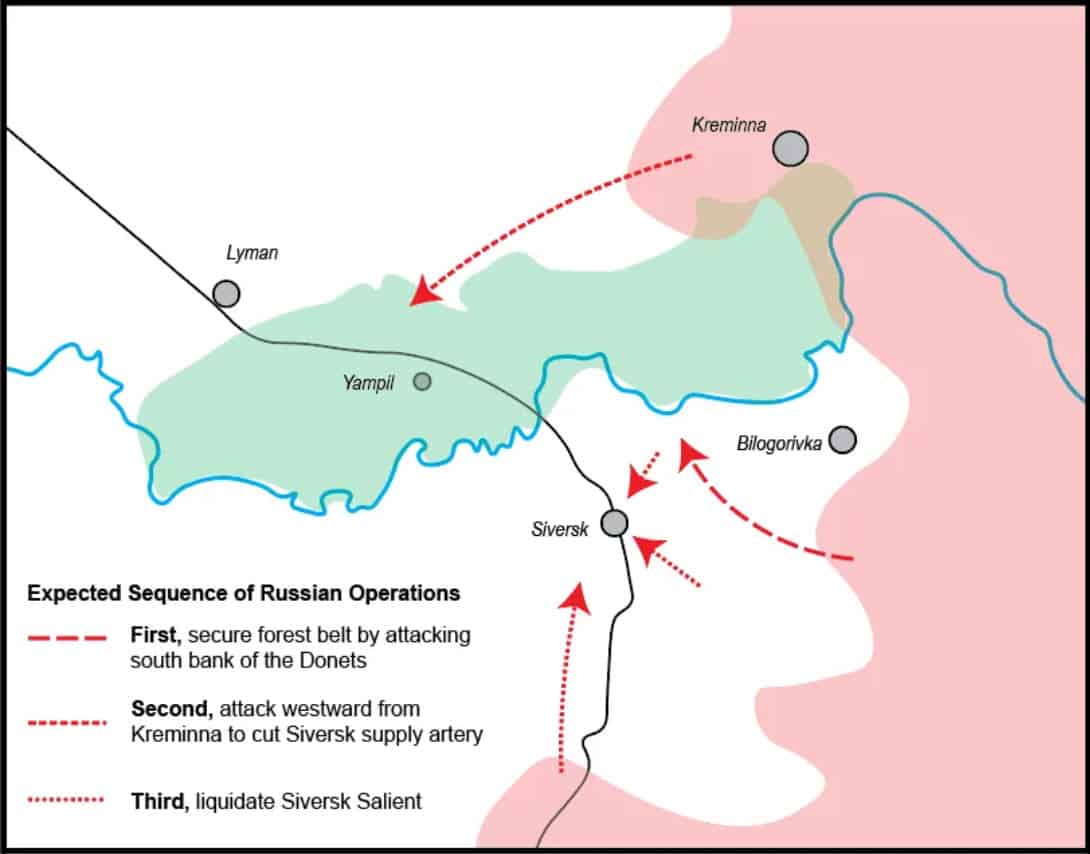
A Russian attack on a northwesterly basis towards the south bank of the Donets River would aim for small settlements with such forgettable names as Serebryanka and Grygorivka. Surely, the capture of such villages is hardly likely to put the fear of God in the Jake Sullivans and Victoria Nulands of the world - I fear nothing earthly can. Yet a Russian push towards the south bank of the river will sever the routes being used to sustain Ukrainian forces in the forest belt on the *north* bank of the river. This, in turn, would allow Russian forces out of Kreminna to secure the forest belt and neutralize the threat on their left flank as they resume attacking actions westward towards Lyman. They don’t even need to capture Lyman itself in the near term, as reaching the village of Yampil would be sufficient to cut the last remaining supply artery to Siversk (the southern routes having been severed by Russian forces around Bakhmut) and create the conditions for Russia to liquidate the entire Siversk salient.
In short, this forest zone and the corridor from Kreminna to Lyman acts as the hinge between the Lugansk and Donetsk fronts, and even more specifically this forest belt directly along the Donets river acts as the hinge between Kreminna and Siversk. In 2022, this was the sort of terrain that Ukraine had success exploiting owing to Russia’s infantry-light force composition. With this problem now being rectified, Russia has the forces to properly secure these forests, and can accelerate this process by severing the river crossings that Ukraine relies on to sustain its units in the forest belt.
Ugledar: Anatomy of a Battle
At the moment, the front in Ukraine is active in many places, with measured Russian advances on the Oskil River river line, a steady grind of heavy combat in the forest zone between Lyman and Kreminna, and of course the Wagnerian death pit at Bakhmut. These are important and high-intensity areas of combat, but there is at present nothing that could be rationally called a “big arrow” developing.
In light of this overall situation, I thought that this might be a good opportunity to look at a particular section of the front and think about the ongoing battle in high resolution. More specifically, I want to make a close examination of the ongoing battle in the Ugledar sector - let’s discuss not only why it is important, but also see the granular details of the Russian assault, Ukrainian countermeasures, and potential future progress.
Ugledar (some maps may use the Ukrainian formulation “Vuhledar”) is a rather curious little town with a prewar population that probably never exceeded 15,000. The town itself is a dense cluster of concrete apartment blocks sitting out on an expanse of remarkably flat steppe - flat even by Ukrainian standards.
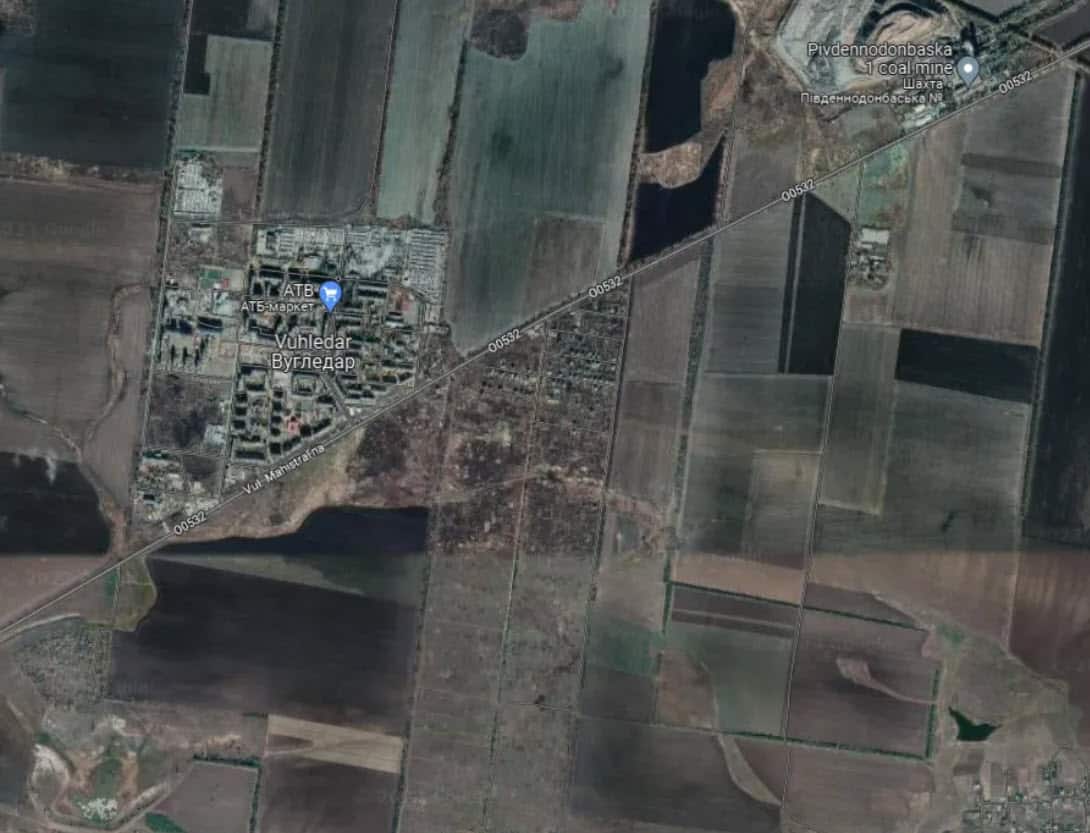
Ugledar and its environs
Ugledar has an outsized operational significance for Ukraine, both for offensive and defensive purposes. The current frontline has Ukrainian forces holding a bulge, or salient, to the southwest of Donetsk city. This bulge is distinctive in that it is the Ukrainian position which is closest to the trunk rail line connecting Donetsk with Mariupol and the land bridge to Crimea (and thus presents the most immediate Ukrainian threat to Russian logistics in the south). The shoulders of this bulge are anchored by Ugledar and Marinka - and behind Ugledar in particular there are no good places for Ukraine to anchor their defense of the salient.
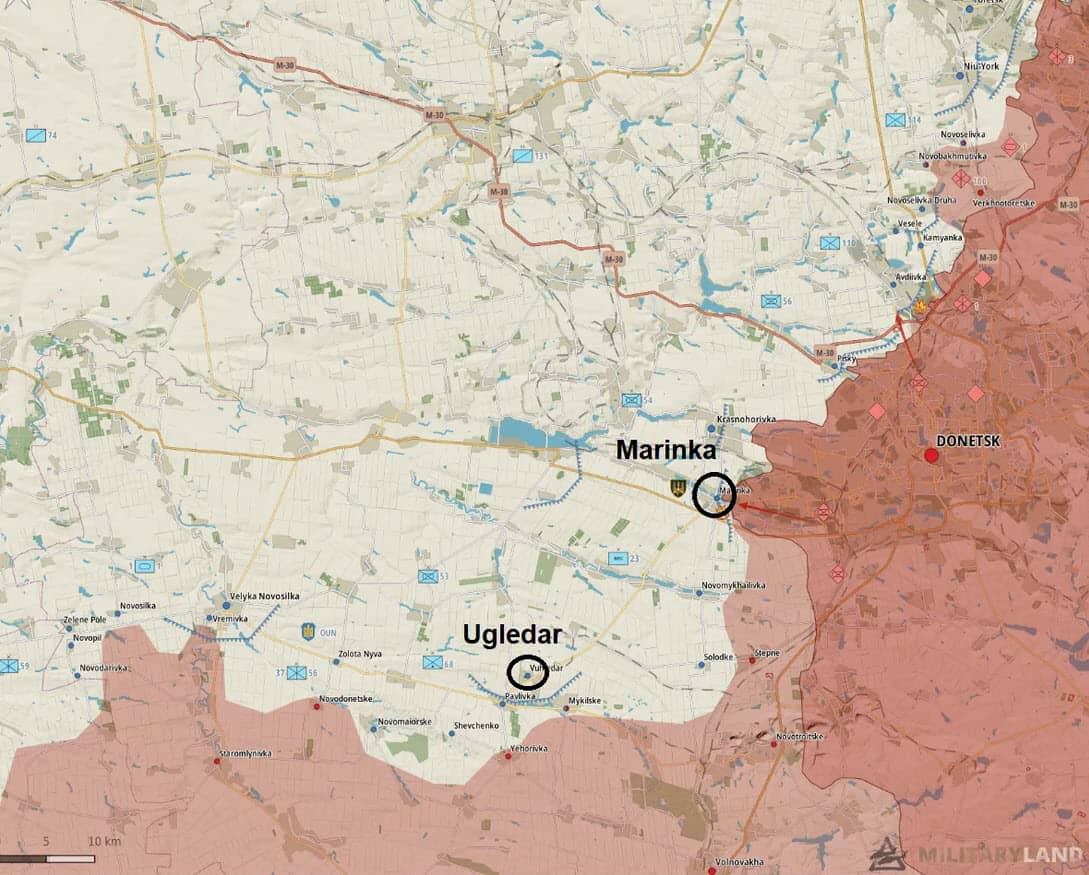
Ugledar and the Donetsk Salient (Map by MilitaryLand)
So long as the Ukrainians hold Ugledar, they will hold this salient and have a position from which to threaten Russian rail traffic. If they lose Ugledar, the rollup of this entire salient will be a forgone conclusion. It is thus trivially obvious why this position is a priority for both Russia and Ukraine.
This brings us to Ugledar itself and the ongoing battle for its control. It is immediately obvious why the town would be difficult to crack. It is characterized by densely packed and extremely robust concrete apartment blocks, and the flatness of the terrain on the approach gives the Ukrainian defenders a clean field of vision. This is a physically resilient position with a commanding view of the surrounding area.
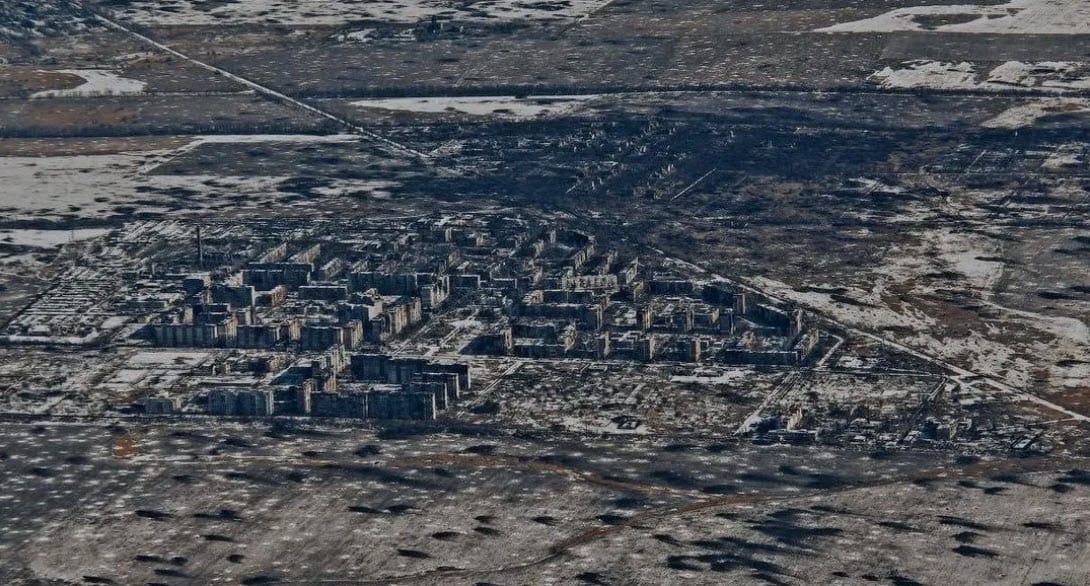
The aerial view of Ugledar from the northwest
The battlespace here is small and easy to parameterize. Ugledar is roughly a mile away from the Russian-held towns of Pavlivka and Mykils’ke. The field on the approach is extremely flat, which makes crossing it in the open an extreme hazard. The most viable line of approach is instead towards the feature known colloquially as the “dachas” - a cluster of houses on the southeastern edge of Ugledar proper.
The dachas are an important feature for two reasons. First, they offer the only real cover on the outskirts of Ugledar itself, and thus become the only real staging point or toehold outside the town. Secondly, they are the natural destination for anyone seeking to advance intelligently, which is to say by way of the tree lines. The fields in this area are separated from each other by very thin and very straight lines of trees. These constitute the only cover on the approach, and are therefore hot real estate. Ukrainian forces routinely dig their trenches directly under these sorts of tree lines, and they create the avenues of advance for Russian forces as well. In the case of Ugledar, following the tree lines brings you directly to the dachas, and as a result these dachas become the natural focal point of any attempt to move on Ugledar itself.
The other feature that is highly relevant is a large coal mine located about a mile and a half to the northeast of Ugledar up the road. This coal mine (though not the mine shaft itself so much as the compound of industrial buildings around it) is a subsidiary Ukrainian position with a garrison of its own as well as logistical elements.
Thus, we get a battlespace that looks like this:
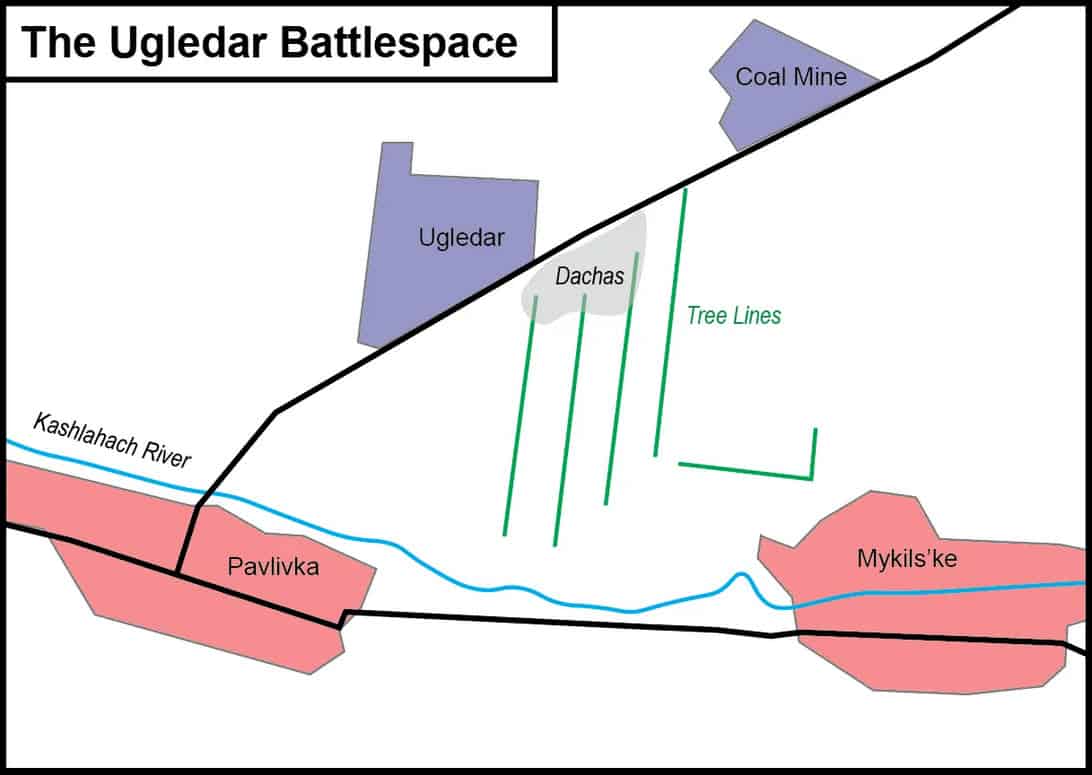
With this understanding of the spatial and geographic aspects, we can look at the ongoing battle for Ugledar. On January 25, Russian forces came surging out of Pavlivka and Mykils’ke and stormed towards Ugledar, rapidly reaching the dachas and largely clearing them out. There was at this point confirmed fighting within Ugledar itself, although it is likely that the Russian intention was not to storm the town block by block but rather to cut it off (there are really only two roads into Ugledar under Ukrainian control) and force a UA withdrawal through a rapid envelopment.
This initial Russian surge seems to have caught the Ukrainians off guard, based on the speed with which they were able to clear the dachas and advance up into the eastern outskirts of Ugledar. An officer with 105th DNR Regiment, which participated in this first assault, told Russian correspondents that they believed the Ukrainian grouping in Ugledar could be finished off with a strong push overnight and that an ultimatum to surrender would be issued (indicating that they anticipated enveloping the town).
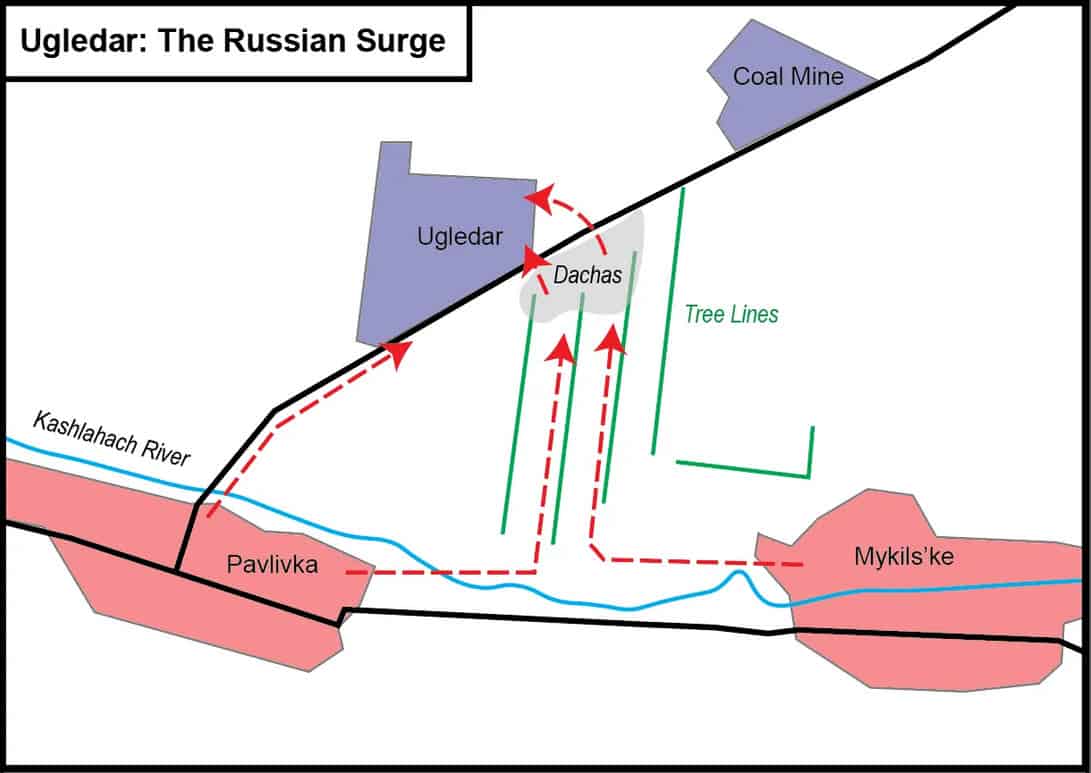
It was at this point that the Ukrainians responded quickly and with great force. A few factors were at play here. First, UA command clearly views Ugledar as a priority position and almost immediately sent reserves in to the town (Ukrainian sources claim that reserves earmarked for the Kreminna axis were redirected).
Secondly, Ukraine benefits from having artillery batteries in Kurakhove, some fifteen miles to the north. This is pushing the extremity of ranges for some systems, but Kurakhove is a strong firing position because it allows Ukraine to cover both the Ugledar and Marinka sectors. If you remember the bulge in the line that we noted earlier, Kurakhove is something like a pivoting fire point that allows Ukrainian artillery to reach around the perimeter of the bulge.
Finally, and perhaps most importantly, the Russian assault force neglected to attack or at least suppress the coal mine to the northeast of Ugledar. Ukrainian forces there were able to organize a quick counterattack, which came at an oblique angle towards the dachas. Once reserves arrived in Ugledar and counterattacked as well, Russian troops were forced to fight for their position in the dachas.
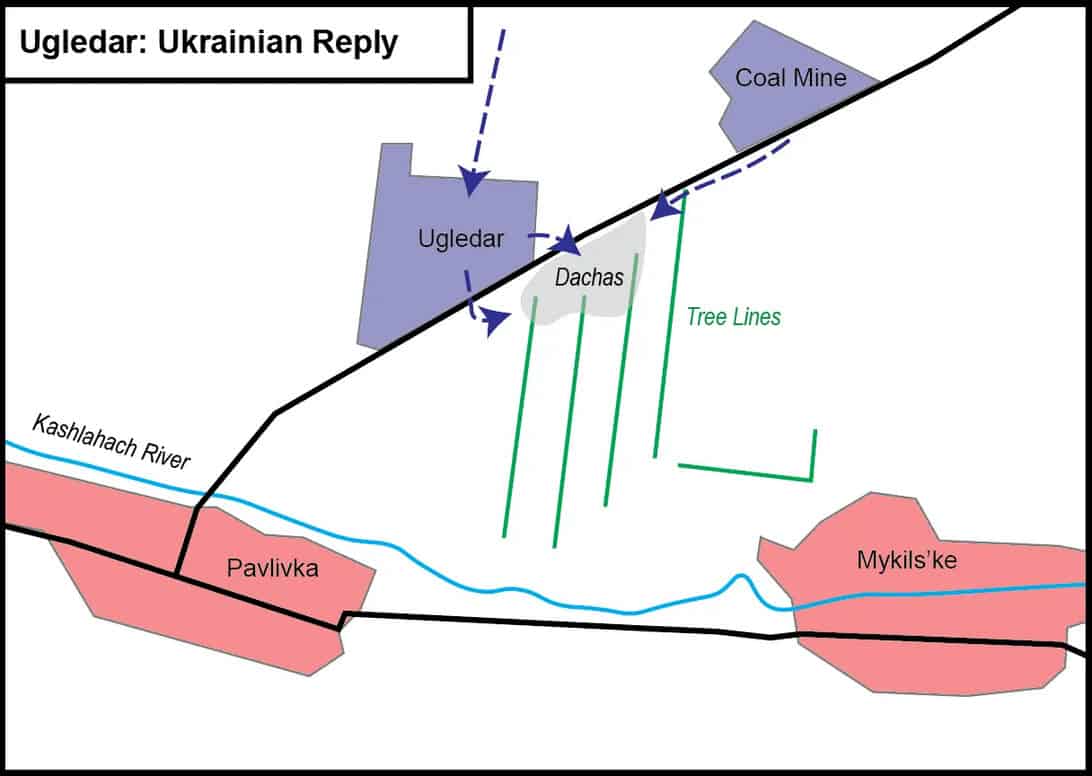
Ukraine’s quick counterattack, artillery coverage from Kurakhove, and the arrival of reserves ended Russia’s chance of overwhelming Ugledar in the first wave, and the battle has now developed into a much larger affair with more forces being committed by both sides. The struggle has largely centered on the dachas and, of course, those tree lines which form the avenues of advance for both sides. Satellite imagery shows that shelling has been concentrated along these tree lines
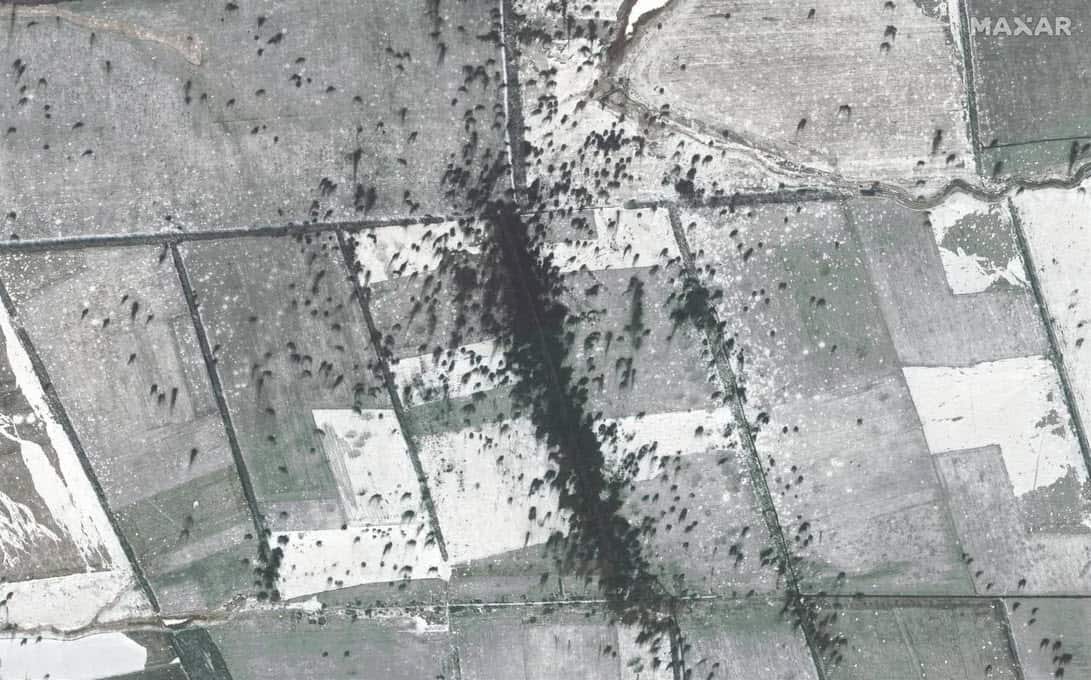
Maxar satellite images of shell impacts
Even more impactful, perhaps, have been the UA’s intensive efforts to mine the approaches, including with remote laid mines (essentially, hollow artillery shells are packed with a stack of mines and scatter the little buggers all over). Given the difficulties of making the approach to Ugledar over the open ground even in the absence of mines, and the confined and linear nature of the avenues of approach, a direct assault on Ugledar is at this point a fool’s errand, and it seems Russia is no longer attempting this at all.
The battle appears to be undergoing a clear shift. Two items in particular stand out - first, that Ukrainian forces not only advanced through the dachas, but even managed to cross the field towards Russian held Pavilvka and Mykils’ke. Secondly, however, Russian forces are holding positions and pushing out to the eastern edge of the dachas and have brought reinforcements in through Mykils’ke.
This suggests the following scheme, broadly speaking. Russian efforts now seem to be shifting away from Ugledar towards the coal mine. This would further isolate the Ugledar garrison and position Russian forces to envelop it from the east. Simultaneously, however, the Russian force seems to have given up the approach to Ugledar and allowed the Ukrainians to come out.
A few days ago, some Ukrainian sources were triumphantly claiming that they had reached the Kashlahach River. This surprised me immensely - advancing that far is a very bad idea for the Ukrainians. It is extremely unlikely that Ukraine can successfully attack in this direction - Pavlivka and Mykils’ke are both under well consolidated Russian control, and perhaps most importantly the main highway supplying these towns is behind the river. If Ukraine opts to attack, then all the aforementioned difficulties of the terrain now play in Russian favor, and it will be the Ukrainians attempting to project a force across the field along those narrow tree lines, with no way to screen or cut
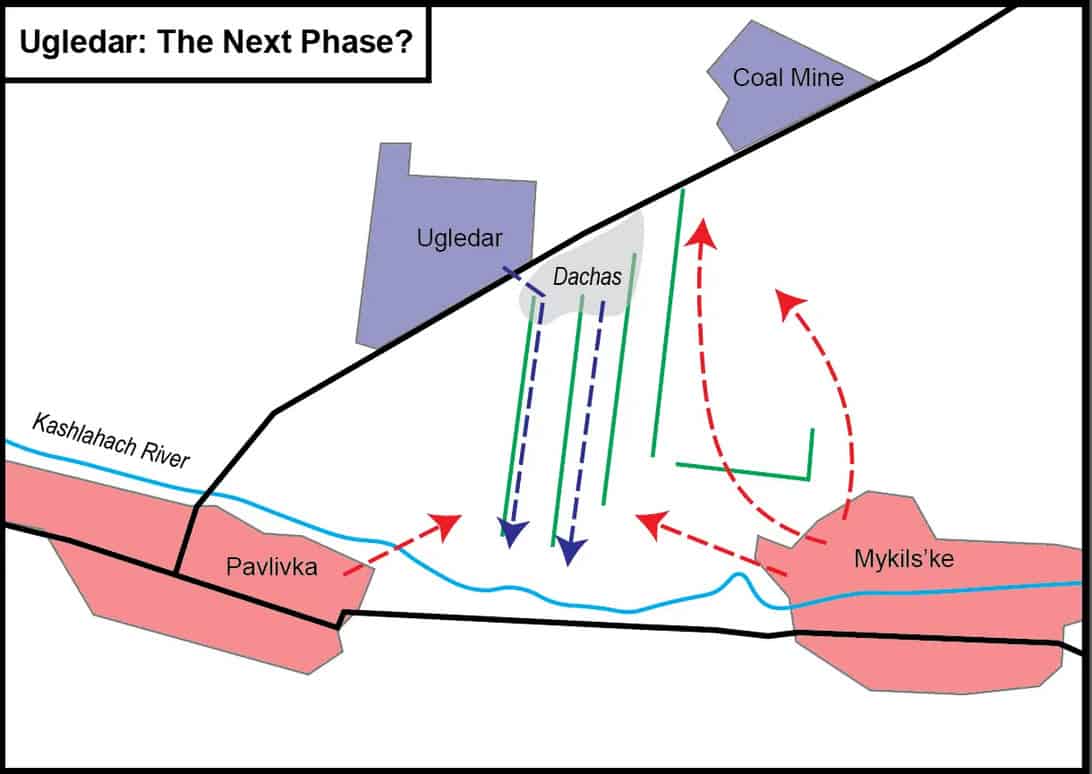
Furthermore, the avenue of approach for the Ukrainians happens to emerge between the two Russian held towns. Any successful Ukrainian attack would therefore require them to force a river while under threat of envelopment. All in all, the best decision for the Ukrainians would be to move out no further than the dachas, and remain safely in Ugledar’s shadow. But if they want to come out across the field into a killing zone, I suspect the Russians are happy to let them do so while they prepare work on the coal mine.
Ugledar has so far presented as a fascinating and fiercely contested battle. The initial Russian surge towards the town was uncharacteristic of a Russian army that has shown a preference for methodical and plodding movement. At the same time, there is no denying that Ukraine contested the Russian attack decisively and intelligently. The media and propaganda sphere has attempted to portray the battle as the scene of horrific Russian losses. There was a claim made, for example, that the entire 155th Marine Brigade was destroyed. This, needless to say, is a bit hard to believe given that the 155th Marine Brigade is still actively fighting in this sector and a steady drip of combat footage continues to emerge. Funnily enough, this brigade was also supposedly destroyed in November in a supposedly failed attempt to capture Pavlivka, and in the end neither the destruction of the brigade nor the failure of the attack turned out to be true. Oh well.
All that being said, Russian losses are real - probably on the order of 300-400 men and a few dozen assorted vehicles, but this is simply the reality of high intensity combat. Ukrainian losses in this sector are similarly intense, and the successful stabilization of the front forced Ukrainian command to denude their reserves in other critical sectors of front. Perhaps even more importantly, the surge of Ukrainian forces into this sector completely changed the calculus of the battle, with Russia bringing more heavy weaponry to bear and creating yet another attritional death pit.
The future at Ugledar remains cloudy. New footage was released this morning (February 24) showing Russian airstrikes on Ukrainian positions around the coal mine, suggesting that they may indeed proceed with an attempt to assault the mine and envelop Ugledar from the east. It is also possible that Ugledar becomes yet another grinding positional battle, which could be undone for the Ukrainians by a Russian advance elsewhere. If, for example, the Russians break the Ukrainian line in Marinka and advance to threaten Kurakhove, Ugledar could lose the vital artillery umbrella that has made the successful defense possible.
For now, this battle is fascinating because it shrinks the entire drama of the war to a very small scale. Tens of thousands of men have been bravely contesting the issue in an arena of no more than fifteen square miles, and in many cases life and death has been adjudicated by control over a narrow dirt track under a line of trees.
Amid the grand pronouncements of political leadership and endless fretting over big arrows drawn on the map, it does us well to remember that the fate of the world is built on the accumulated efforts of these brave individual soldiers. Indifferent to the endless bloviation about war aims and the inane chattering about “the rules based international order”, multipolarity, and mundane geopolitical interests, events on the ground are carried forward by men whose war aims are very simple indeed. On the snow covered Pontic steppes around Ugledar, what the warrior desires more than anything is not to be shot.
Scars of Empire: Moldova and Transnistria
Perhaps one of the more notable developments in the last few weeks was the simultaneous emergence of two alleged plots to widen the conflict. On February 21, the Ukrainian government claimed to have intelligence warning that Russia planned to perpetrate a “coup” in Moldova by seizing the airport in the capital of Chișinău and inserting troops by airlift. Within 24 hours, Russia countered with a claim that Ukraine was in the process of preparing to invade the interstitial and legally ambiguous territory known as Transnistria.
This is probably all very confusing to casual observers. If Eastern European history and/or politics are not your cup of tea, then you have probably only heard of Moldova in passing, and perhaps you’ve never heard of Transnistria at all, so it may be that a brief foray into the historical background may be useful.
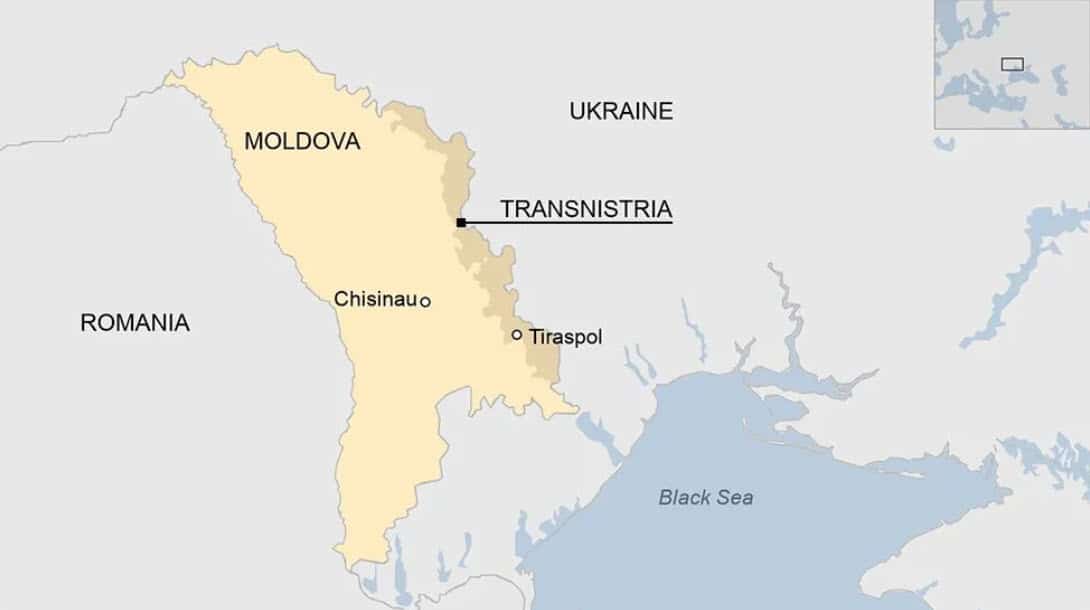
A Russian Nesting Doll of Imperial Debris
Moldova is one of those little states that was predestined to be a piece of geopolitical shrapnel. Moldovans themselves (as an ethnos or people) are really a derivative of Romanians - the supermajority of the country speaks Romanian and the dominant religion is Eastern Orthodoxy in liturgical Romanian. Genetically, Moldovans seem to have more Slavic ancestry than Romanians proper, but that is perhaps outside the scope of this little essay.
In any case, this begs the question: why is Moldova a thing, as opposed to simply a nice coastal province of Romania? The answer, succinctly, is that the state simultaneously sits at two important convergence points - one political, and one geographic.
Politically (that is, historically) speaking, Moldova sat at a sort of connective tissue where three great empires abutted each other - the Russian, Ottoman, and Austrian empires more specifically. In particular, for much of modern history the territory which is now Moldova lay directly on the border of the Russian and Ottoman Empires, and was thus highly coveted. The desirability of this lithospheric little region was further enhanced by its geographic qualities. Very simply, Moldova occupies a historic territory known as Bessarabia, which comprised the easily traversable gap between the Carpathian Mountains and the Black Sea.
Bessarabia (the future Moldova) was subject to perennial coveting and hand changing, with both the Russian and Ottoman powers desiring to control that crucial corridor between the mountains and the sea. The emergence of an independent Romanian state in the 1800’s further complicated matters with yet another party desiring this strategic parcel. In the end, the Second World War brought about an end to the controversy, with a victorious Soviet Union planting the hammer and sickle over the Bessarabian Gap through the creation of the Moldavian Soviet Socialist Republic. The Moldovan question was resolved… for a time.
The Berlin wall fell. The Soviet Union began to unwind, and again Moldova’s political future became an open question. In June 1990, the Moldovan Republic became one of a number seeking to leave the Union, but not everyone agreed. Soviet loyalists and ethnic Russians living in Moldova recoiled at the thought of leaving the Union and being left alone in a majority Romanian state, and in response they declared the formation of the Pridnestrovian Moldavian Soviet Socialist Republic, which would soon be better known as Transnistria.
The name Transnistria is actually a very useful and descriptive one. A derivative of “Trans-Dniester” - it refers very literally to a strip of land between the Dniester River and the Moldovan Border, which seceded from Moldova in 1990 and declared an ongoing commitment to the USSR. A rather peculiar question then arises - is Transnistria a loyalist or a separatist entity? From the point of view of Moscow, the Transnistrian authorities are loyalists who refused to join the Moldovan exit from the USSR. For Moldovans, of course, the Transnistrians are separatists. How they will be regarded by history will almost certainly be determined by who wins and loses the struggle for power in Eastern Europe.
All this is to say, there are now two statelets on the Black Sea littoral that represent imperial debris. Moldovia is an ethnic Romanian state occupying most of the gap between the Carpathian Mountains and the Black Sea, and Transnistria is a pro-Russian pseudo-state which broke away from Moldova during the Soviet collapse. Now, in February 2023, Ukraine and Russia are accusing each other of plotting to invade these little strips of geopolitical shrapnel.
Let’s begin with the Transnistrian issue. Two salient questions manifest themselves: why would Ukraine want to invade Transnistria, and would such an attempt be successful?
The rational for Ukraine invading Transnistria is somewhat muddled. Many have suggested that Ukraine might be motivated to seize the contents of Transnistria’s Cobasna Ammunition Dump - once a logistical support for the Soviet 14th Guards Army which was stationed in the region. Now, the Cobasna depot is one of the largest ammunition dumps in Europe, with up to 20,000 tons of Soviet era munition still located there. With widespread reports that Ukraine is desperately low on ammunition, the Cobasna facility is perhaps a lusty target buxom enough to rustle the jimmies of the Ukrainian general staff, though it is unlikely that the entire contents of the depot are usable. Many of the munitions are likely defunct due to age and neglect at this point, but there’s probably still a significant stock of usable ordnance. The fact that the ammo dump is less than three miles from the Ukrainian border raises the appeal to perhaps irresistible levels.
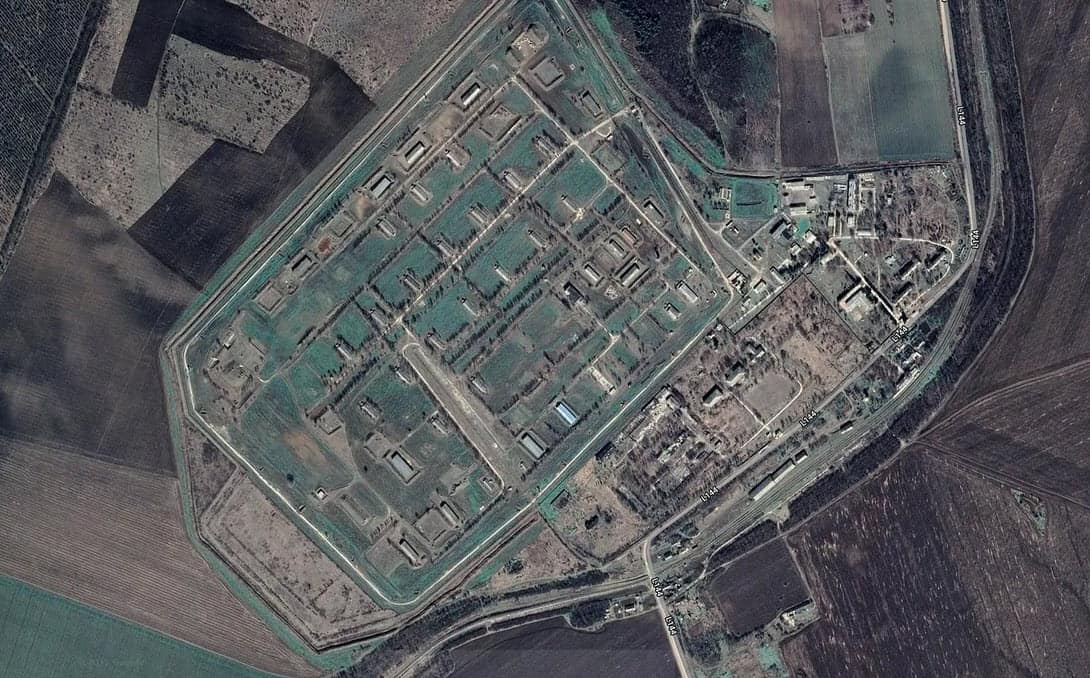
The Cobasna Facility
Transnistria, of course, is not exactly defenseless. Given that it is more or less a statelet formed around hardliner remnants of the Red Army, it is much more militarized than one would expect for a region with a population of less than half a million. In fact, Transnistria has more heavy equipment than Moldova does, and can field a handful of passable motorized infantry brigades. There is also a garrison of Russian soldiers in Transnistria, though these are relatively lightly equipped and were deployed mostly as a tripwire force during peacetime.
The verdict on Transnistria is that it punches above its weight class and is probably a much tougher nut to crack than one would initially assume, but it is isolated and would be unable to resist a determined Ukrainian attack under normal circumstances, though at this point it’s unclear what sort of resources Kiev could dedicate to what would amount to an armed raid to steal ammunition.
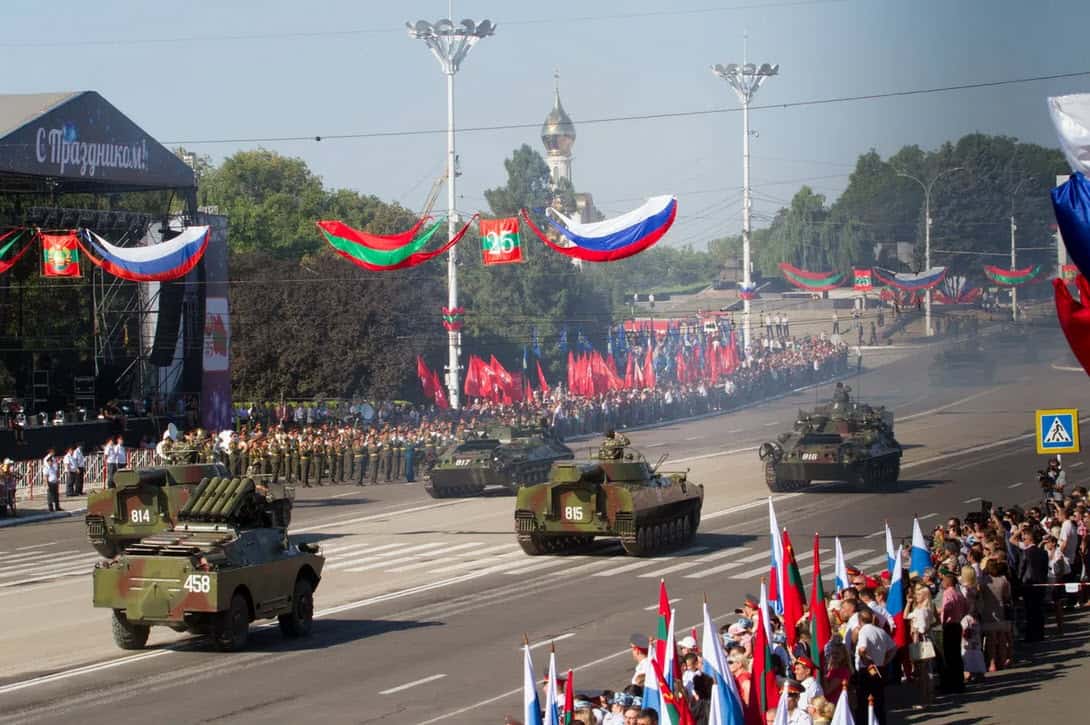
The Glorious and All Conquering Armed Forces of Transnistria
All that being said, we must remember that the Cobasna ammunition dump is located extremely close to the Ukrainian border, and securing it would thus not require pacification of all of Transnistria. The Ukrainian army would merely need to secure a salient a few miles deep and screen the depot from the nearby city of Ribnita while they transferred its contents back to Ukraine. It would be difficult for the forces in Transnistria to contest an objective so close to the Ukrainian border, and it’s therefore highly likely that measures have already been taken to destroy the ammunition dump in the event of a Ukrainian incursion - an act which could produce an explosion nearly the size of the atomic bomb at Hiroshima, albeit without the pesky radiation.
This suggests a paradox. The Cobasna depot is so vulnerable to a Ukrainian raid that it ceases to become a realistic target, as it will be simply be detonated the moment the UA comes near it. Ukraine would then find itself facing a pointless new front in its rear which would almost certainly require Ukrainian regular units (not just territorial defense) to pacify.
This brings us back to Moldova. The Transnistrian issue is a sensitive one for Moldova, which views the little Transnistrian statelet as a separatist Moldovan province, and tends to view it as a Russian mechanism to both forward deploy troops and put pressure on the Moldovan government. It is not quite correct to view Transnistria as some sort of Russian plot, simply because the creation of Transnistria was the result of spontaneous ground-up action in the region itself, and not centrally directed by Moscow, but it is undoubtedly a sore spot for Moldova.
This is why Ukraine has consistently framed the Transnistrian question as being “up to Moldova.” In other words, Ukraine will probably by hesitant to move on Transnistria in a naked attempt to steal the Cobasna stockpile - it would instead like to portray its intervention there as being at the request of the Moldovan government - “this is Moldova’s land, and we are intervening at their request to help them get it back.” This is likely the reason Ukraine has been claiming of a supposed Russian plan to overthrow the Moldovan government - they would like to create a political environment where Moldova greenlights a move on Transnistria, and participates with its own forces.
Let’s take stock of the larger situation and figure out what’s going on with these rumors. Widening the war to Moldova and Transnistria does not suit Russian interests. Any operations occurring on the Transnistrian axis would be very difficult for Russia to manage, as they would have to be sustained entirely by airlift, and even more specifically overflights of Ukrainian or Moldovan territory.
Meanwhile, Moldova almost certainly wants to maintain its neutrality (which is codified in the country’s constitution and is the reason the country is not a NATO member) and is thus highly unlikely to greenlight a Ukrainian move into Transnistria in the absence of some prior Russian provocation.
Ultimately, the only party that would seem to benefit from widening the conflict into the Moldovan space would be Ukraine, both because it covets the Cobasna depot and because widening the conflict is generally a Ukrainian goal - in their crude calculation, any escalation that raises the probability of direct western intervention is beneficial. Moldova, of course, is not a NATO member, but no doubt Ukraine would like to set off a spiraling expansion of the theater and see if, say, Romania could be dragged in. All that being said, Kiev should probably expect the Cobasna depot to simply be detonated the moment they move on it, making the entire scheme an ill-conceived waste of resources.
On the whole, I’m skeptical that anything will occur on this front. The simultaneous finger pointing by Moscow and Kiev is strongly reminiscent of the period last year where both parties began to simultaneously accuse the other of plotting to detonate a dirty bomb. Ukraine tries to manufacture a crisis to raise more urgency in the west and to stoke panic and distraction in Russia, and Russia replies with counter-accusations and escalation management. Above all, this is a stark reminder that for Ukraine - being entirely dependent on its western benefactors to sustain its war making - this war is being fought in front of an audience.
I have been fairly consistent from the beginning in that I expect the war in Ukraine to be fought to its conclusion and remain a contained conventional conflict - that is to say, I neither expect nuclear weapons usage nor additional belligerents to enter the war, be it Belarus, Poland, Moldova, or NATO proper. I believe we’ve already seen the qualitative extent of outside involvement in the war - NATO providing training, ISR, weaponry, maintenance, and sustainment, Belarus being used for Russian deployments, and Russian allies like China and Iran providing mainly standoff weaponry. For now, none of the developments around Transnistria seem to credibly upset this calculus. For now, we wait and see if Ukrainian ammunition shortages become so dire that they simply can’t resist taking a pass at the Cobasna depot.
Summary: Life in the Death Pit
For someone sitting safely in their home far away from the Donbas, it is easy to trivialize the combat that is currently ongoing as unimportant, simply because places like Ugledar, Bakhmut, and the forest belt south of Kreminna do not seem to be particularly important places. This, of course, is rather silly. What makes a place important, in that unique context and under the novel strategic logic of war, is the fact that two hostile bodies of armed men are colliding there. History is replete with such reminders - Gettysburg, Stalingrad, and Điện Biên Phủ were not particularly important of their own accord, but they took on an outsized significance because that’s where the enemy was.
Victory in Ukraine will be won when one army or the other has lost its ability to offer armed resistance - either through the breaking of political will, the destruction of heavy equipment, shattered sustainment, or manpower losses. The word “attrition” has become rather commonplace and is routinely thrown around in reference to the current Russian approach, but few want to contemplate what this really means - for it implies, above all, killing Ukrainian soldiers in large numbers, hunting and destroying critical systems like artillery and air defense, and making Ukrainian rear areas non-functional. Where better to fight than Bakhmut, where Ukrainian infantry survive for mere hours on the front line?
Russian command could, perhaps, paraphrase American Lt. Col. Hal Moore, who famously said of Vietnam: ““By God, they sent us over here to kill Communists and that’s what we’re doing.”
One of the great peculiarities of this war is the degree to which Kiev is dependent on western help to sustain its war making. This is in some ways both an advantage and a disadvantage for Russia. The downsides are obvious, in that it puts most of Ukraine’s ISR, armaments production, and sustainment beyond Russia’s reach. Moscow can hardly begin shooting down American AWACs planes or bombing Lockheed Martin facilities, and so in this regard the dynamic of the war gives Ukraine a unique strategic resilience. But the flip side of this coin is that Ukraine is not truly sovereign, as is Russia with its entirely indigenous war making.
Because Ukraine relies on foreign assistance to continue its war, it must constantly be in a performative mode and under pressure to deliver visible successes. This is why it is anticipated that Ukraine will use the vehicles currently being delivered to launch a counteroffensive against the land bridge to Crimea. It really has no choice in the matter. In contrast, Russia is under no intense time pressure except that which it imposes on itself, and this freedom of action gives it the luxury (so long as battlefield events do not interrupt it) of sorting out an organizational overhaul and resisting the temptation to move prematurely.
Of course it would be much better not to have organizational problems in the first place, but discretion remains the better part of valor. And for now, there is no great hurry, for the entire front has become a death pit which is absorbing Ukrainian manpower and equipment and sapping the Ukrainians of reserves and initiative.
The vain world that we inhabit in the west is being exposed to the realities of true power. After yet another impotent condemnatory vote in the United Nations and a visit to Kiev by America’s favorite gerontocrat, the western clerisy’s interest in the Ukraine War shows little signs of waning, but perhaps gradually they are becoming aware that this is a plane of existence that they can little comprehend, let alone influence. They can only watch.
In the forest around the Donets, on the steppe at Ugledar, and in the burning death trap at Bakhmut, words matter little. Indeed, the destructive power now at work is so great that even the deeds of the individual can do little to alter the course of the battle - and yet on both sides, men of superior will continue to execute their duties, demonstrating discipline and bravery in the face of the constant possibility of death. Such men of iron are perhaps beyond the understanding of postmodern cultures, but it is they who will determine the fate of Ukraine and Russia.
Big Serge Thought
https://bigserge.substack.com/archive Be sure to take a look at the many Substack articles that Big Serge has written. Notice that he has researched many on "The History of Battle" that are very informative. Consider starting with The Soul of Battle, which serves as his introduction to a new series of articles on the history, theory, and practice of warfare.